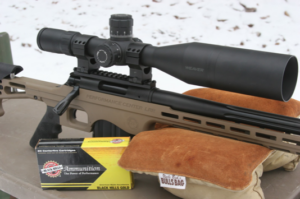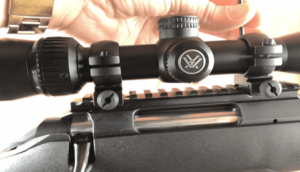How To Adjust A Rifle Scope For Windage And Elevation
By Loyal Brenzy, www.huntingmarkcom
The first point in answering this question is to consider the fact that each and every type of gun sight has some method of adjusting it to send the bullet dead center into the bullseye.
The modern scopes are no different. The sight uses adjustment knobs that move the bullet impact point to the target center.
 One knob moves the elevation point up or down (elevation turret); the other moves the windage impact point in the same way (windage turret). If a third knob is located on the turret of the scope, it is most likely a control for adjusting parallax or focus.
One knob moves the elevation point up or down (elevation turret); the other moves the windage impact point in the same way (windage turret). If a third knob is located on the turret of the scope, it is most likely a control for adjusting parallax or focus.
Zeroing
When adjusting the scope sight the term used is “zeroing” the rifle scope. This means a given range to shoot and adjust the rifle scope to hit the target dead center.
Sounds easy, and it is. However, some folks get so tied up and over-think the problem to the point that they shoot piles of ammo and end up with a rifle shooting an impact point someplace near the center of the target, or in other cases nowhere near at all.
When you are sighting-in a scope, follow these simple rules.
First of all, assuming the scope has been installed correctly, get the rifle and scope set in place by using heavy bags on a solid bench-rest table. No offhand shooting here or leaning up against a tree for support. Those methods are not appropriate at all and will lead to a catastrophe.
What you are about to do is eliminate any element of the scope moving during the sighting-in (zeroing) process. If the bullet is not fired to the correct point of hold, it will not be the fault of the scope or the rifle.
Set up a target at 25 yards.
No, not 100 or 200 yards, but exactly 25 yards. This is easier to hit, and easier to adjust your scope sight, which will move the point of impact to the center of the target. Now, from a solid rest (see above), aim at the dead center of a sight in pattern. This can be as simple as a 1-inch dot on a piece of copy paper.
 Shoot 1 round and mark the hit position on the target. Let’s say it hit 2 inches to the left, but the line (elevation) was good. Turn the windage turret, or turret controls, to the right. Because the turret scope adjustments are set in ¼-inch or ⅛-inch clicks at 100 yards, you need to make extra turns for closer ranges.
Shoot 1 round and mark the hit position on the target. Let’s say it hit 2 inches to the left, but the line (elevation) was good. Turn the windage turret, or turret controls, to the right. Because the turret scope adjustments are set in ¼-inch or ⅛-inch clicks at 100 yards, you need to make extra turns for closer ranges.
I will not be exact here because scopes can be a bit off in the exact number of turns to match short of the 100-yard system. However, at least tripling the turns required at 100 yards should do the tick. At 2 inches, turn 15 clicks (for example) and fire another round.
If the bullet is still not centered.
Check the bullet impact point on the target in terms of the distance required (up/down or left/right) to hit the center, and make the necessary number of clicks once again. With some practice you should be able to learn your scope and then zero any time with as few as three rounds down-range.
By making that centered hit at 25 yards, you’re going to be on target regarding a 10X12-inch target at 100 yards but lack the extra range and possible aiming error in the process.
After shooting at 25 yards, re-shoot for conformation at 100 yards. That task completed, you’re home free in terms of adjusting and sighting-in a rifle scope. In general, I try and shoot a 3-shot group at 100 yards to totally verify my exact zero.
 While scopes differ slightly, they all have zeroing systems that are much like what I have outlined above. Each scope comes with a simple, easy-to-read manual.
While scopes differ slightly, they all have zeroing systems that are much like what I have outlined above. Each scope comes with a simple, easy-to-read manual.
As the saying goes: “When all else fails, read the directions.”
There are several other ways to zero a rifle. However, the above method makes direct use of the scope’s controls to guide the bullet to the target’s center. After all, that is exactly what you’re trying to do in the first place.
If you like stories like this, then make sure to check out our blog page on our website. To see more Record Book Bucks from Oak Creek just click the link!

Recent Comments